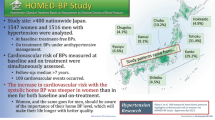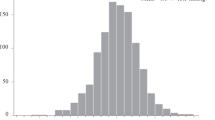Abstract
Whether menopause would be associated with a rise in blood pressure (BP) was prospectively assessed in a cohort study. A total of 315 women (30–70 years at follow-up) were randomly selected from the population. They were matched on age and rank of body mass index with 315 men. Five BP readings were obtained by conventional sphygmomanometry (CBP) at the subjects’ homes on each of two baseline visits and at one follow-up visit. The 24-h ambulatory BP was recorded at follow-up. Menstrual status was assessed by questionnaire. The statistical tests were two-sided and accounted for age, body mass index, antihypertensive treatment, contraceptive pill intake or changes in these variables. From baseline to follow-up (median, 5.2 years), 166 and 105 women stayed pre- or postmenopausal, while menses ceased in 44 perimenopausal women. In cross-sectional analyses, the postmenopausal women, compared with their pre- and perimenopausal counterparts, had a 4–5 mm Hg higher systolic CBP (15 readings per subject) and 24-h BP (P ⩽0.05 for differences between peri- and postmenopausal women). Furthermore, systolic CBP rose nearly 5 mm Hg per decade more (P ⩽ 0.05) in peri- and postmenopausal women than in premenopausal subjects. In addition, the longitudinal results showed that systolic CBP did not change in women who stayed premenopausal throughout follow-up (P = 0.71), but increased by approximately 4 mm Hg over 5 years in peri- (P = 0.07) and postmenopausal (P = 0.01) subjects (P = 0.02 for difference between pre- and postmenopausal women). Such trends were not observed for diastolic BP in women or for systolic and diastolic BP in men. In conclusion, menopause per se may potentiate the age-related increase in systolic pressure. Because confined to systolic pressure, this specific effect of menopause may be mediated via a reduction in arterial compliance.
This is a preview of subscription content, access via your institution
Access options
Subscribe to this journal
Receive 12 digital issues and online access to articles
$119.00 per year
only $9.92 per issue
Buy this article
- Purchase on Springer Link
- Instant access to full article PDF
Prices may be subject to local taxes which are calculated during checkout
Similar content being viewed by others
Author information
Authors and Affiliations
Rights and permissions
About this article
Cite this article
Staessen, J., Ginocchio, G., Thijs, L. et al. Conventional and ambulatory blood pressure and menopause in a prospective population study. J Hum Hypertens 11, 507–514 (1997). https://doi.org/10.1038/sj.jhh.1000476
Received:
Accepted:
Issue Date:
DOI: https://doi.org/10.1038/sj.jhh.1000476
Keywords
This article is cited by
-
The importance of regular home blood pressure monitoring over the life course
Hypertension Research (2024)
-
Cardiovascular health in the menopause transition: a longitudinal study of up to 3892 women with up to four repeated measures of risk factors
BMC Medicine (2022)
-
The role of sex and gender in hypertension
Journal of Human Hypertension (2022)
-
Hypertension Across a Woman’s Life Cycle
Current Hypertension Reports (2022)
-
The uncertain effect of menopause on blood pressure
Journal of Human Hypertension (2019)



